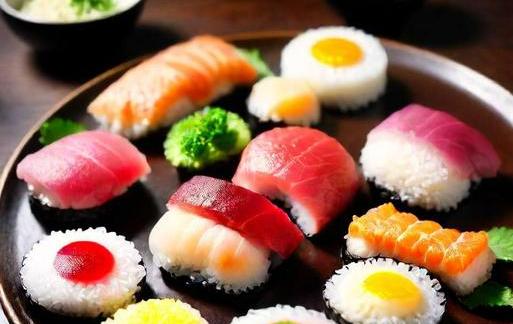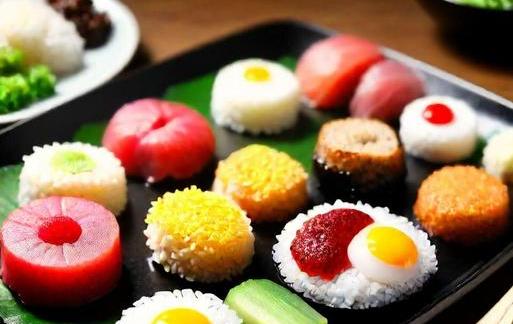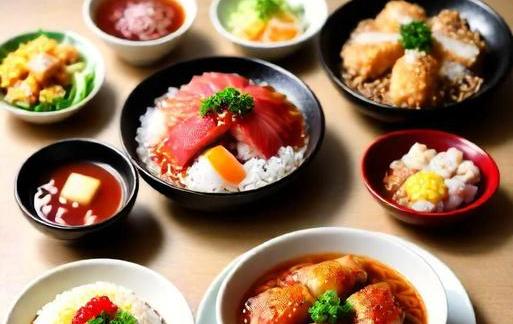- You are here:
- Home »
- Food
- » [REVEALED] Japanese Foods That Start With I
[REVEALED] Japanese Foods That Start With I
Note: This page contains affiliate links.
As an Amazon Associate, I earn from qualifying purchases when you click on the link, but you are not charged extra.
Japanese cuisine is renowned for its diverse and flavorful dishes, each reflecting a unique blend of tradition, innovation, and meticulous preparation. In this culinary journey, we delve into the world of Japanese foods that start with the letter "I." From iconic dishes to hidden gems, the list is as diverse as Japan’s landscape. Join us as we explore the intricacies of these delectable offerings that showcase the culinary prowess of this fascinating country.
Contents
List Of Japanese Foods That Start With I

1. Izakaya
To kick off our exploration, let’s first understand the concept of "Izakaya." While not a specific dish, an Izakaya is a quintessential part of Japanese culinary culture. These are traditional Japanese pubs that offer a variety of small, flavorful dishes meant to be enjoyed with drinks. The atmosphere is laid-back, making Izakayas popular social hubs where people gather to unwind and savor an array of dishes ranging from grilled skewers (yakitori) to edamame.
2. Ika Somen
"Ika Somen" is a unique and visually captivating dish that translates to "Squid Noodles." Thinly sliced squid is skillfully arranged to resemble delicate, translucent noodles. These "noodles" are then served with a dipping sauce, creating a dish that is both aesthetically pleasing and delightful to the palate. The squid imparts a mild seafood flavor, making Ika Somen a refreshing and innovative dish.
3. Inari Sushi
Sushi enthusiasts are likely familiar with Inari Sushi, a delightful variation that features vinegared rice encased in a pocket of sweet, seasoned tofu. The tofu pouch, known as "inari," adds a subtle sweetness to the rice, creating a harmonious blend of flavors. Inari Sushi is not only delicious but also visually appealing, making it a popular choice in sushi assortments.
4. Ishikari Nabe
Hailing from the northern region of Hokkaido, Ishikari Nabe is a hearty hot pot dish that celebrates the abundance of fresh seafood in the area. This one-pot wonder typically includes salmon, vegetables, tofu, and miso broth. The result is a rich and flavorful stew that warms the soul, making it a perfect comfort food during the colder months.
5. Ikayaki
Ikayaki is a grilled or broiled whole squid dish that boasts a savory and slightly sweet glaze. The squid is often scored before cooking, allowing the flavors to penetrate the flesh. The dish is then generously brushed with a thick, soy-based sauce, creating a delectable caramelization. Ikayaki is a popular street food item, enjoyed by those seeking a quick and satisfying seafood snack.
6. Ise Ebi
"Ise Ebi" refers to spiny lobster, a prized seafood delicacy in Japanese cuisine. Known for its sweet and succulent meat, Ise Ebi is often prepared simply to let the natural flavors shine. Grilling and sashimi-style preparations are popular, allowing diners to savor the exquisite taste and texture of this premium crustacean.
7. Imo Yokan
Moving on to sweets, "Imo Yokan" is a traditional Japanese dessert that showcases the versatility of sweet potatoes. Sweet potato paste is combined with sugar and agar to create a firm, jelly-like confection. Imo Yokan can be enjoyed on its own or paired with a cup of green tea, offering a delightful balance of sweetness and earthy notes.
8. Iwashi Nigiri
Nigiri sushi enthusiasts might appreciate "Iwashi Nigiri," featuring sardines atop bite-sized mounds of rice. The sardines are often marinated in a flavorful soy-based sauce, imparting a bold and savory taste. Iwashi Nigiri exemplifies the Japanese approach to sushi, where the simplicity of ingredients allows the natural flavors to shine.
9. Irodori Zushi
"Irodori Zushi" translates to "colorful sushi," and true to its name, this dish is a feast for the eyes. A variety of colorful ingredients, such as fish, vegetables, and tamago (sweet omelet), are artfully arranged atop bite-sized rice portions. The result is a visually stunning plate that not only delights the senses but also showcases the artistry inherent in Japanese culinary presentation.
10. Ikinari Dango
"Ikinari Dango" is a traditional Japanese dumpling made from sweet potatoes. These dumplings are typically grilled or pan-fried, enhancing the natural sweetness of the potatoes. Ikinari Dango is a popular snack during festivals and celebrations, offering a delightful combination of chewy texture and comforting flavors.
The world of Japanese foods starting with the letter "I" is a captivating mix of traditional flavors and innovative culinary creations. From the social ambiance of Izakayas to the visually striking Ika Somen, each dish tells a unique story of Japan's rich culinary heritage. Whether you're a fan of seafood delights like Ishikari Nabe and Ise Ebi or have a sweet tooth for Imo Yokan and Ikinari Dango, Japanese cuisine has something to offer for every palate. As you embark on your gastronomic journey through the diverse Japanese foods starting with "I", savor the nuances, appreciate the craftsmanship, and immerse yourself in the cultural tapestry that defines these culinary delights. The world of Japanese cuisine is vast and varied, and exploring it one letter at a time unveils a treasure trove of flavors waiting to be discovered.
Significance

Japanese cuisine is a tapestry of flavors, textures, and traditions, each dish reflecting the rich cultural history of the Land of the Rising Sun. In this gastronomic journey, we delve into a specific aspect of Japanese cuisine—foods that start with the letter "I." From iconic staples to hidden gems, the Japanese culinary landscape offers a diverse array of options.
Understanding the significance of Japanese foods that start with "I" requires a broader appreciation of the country’s culinary philosophy. Japanese cuisine emphasizes seasonality, simplicity, and presentation. Each dish is meticulously crafted to highlight the natural flavors of the ingredients while embodying an aesthetic that is both visually pleasing and spiritually fulfilling.
The significance of these "I" foods lies not only in their individual flavors but also in the cultural and historical contexts that surround them. Whether it’s a traditional ingredient passed down through generations or a modern culinary creation, each "I" food contributes to the mosaic of Japanese culinary heritage.
Category-Related

1. Izakaya Delights
Izakayas are traditional Japanese pubs known for serving a variety of small, flavorful dishes that pair perfectly with drinks. In an izakaya setting, some notable "I" foods include:
– Edamame (枝豆)
Edamame, young soybeans still in their pods, are a popular izakaya snack. Boiled and lightly salted, these green jewels are not only delicious but also a great source of protein.
– Ika Geso Karaage (イカゲソ唐揚げ)
Ika geso karaage, deep-fried squid tentacles, offer a crunchy texture with a burst of sea flavors. Often seasoned with a hint of spice, these make for a delightful izakaya treat.
– Ikura (イクラ)
A delicacy consisting of salmon roe, ikura is often served on a bed of rice or as a topping for sushi. The glossy, orange pearls provide a burst of briny goodness.
2. Irodori Sushi Selection
Sushi, a globally renowned aspect of Japanese cuisine, boasts a myriad of varieties. Some sushi options that start with "I" include:
– Inari Sushi (稲荷寿司)
Inari sushi features seasoned rice encased in a sweet and savory tofu pouch. Its slightly sweet flavor distinguishes it from other sushi types, making it a unique and delightful choice.
– Iwashi (鰯) Nigiri
Iwashi, or sardines, are a common choice for nigiri sushi. With their rich, oily taste, they exemplify the essence of oceanic flavors in traditional Japanese sushi.
3. Ingredient-Centric Dishes
Japan’s culinary landscape is profoundly influenced by its use of fresh, high-quality ingredients. Two ingredients starting with "I" stand out:
– Ishikari Nabe (石狩鍋)
Ishikari nabe, a hot pot dish originating from Hokkaido, features salmon, vegetables, and miso broth. This hearty dish highlights the region’s bountiful seafood and robust flavors.
– Ito Konnyaku (いとこんにゃく)
Ito konnyaku, also known as "shirataki noodles," is made from konjac yam. These translucent, gelatinous noodles are a low-calorie, gluten-free alternative, often used in hot pot dishes or stir-fries.
Common Themes
While the "I" foods in Japanese cuisine may seem diverse, there are common themes that thread through many of these dishes:
1. Umami Explosion
Umami, the fifth basic taste, is a central theme in Japanese cuisine. Many "I" foods, such as ikura, inari sushi, and Ika geso karaage, showcase the mastery of umami. The combination of savory, salty, and sometimes sweet flavors creates a symphony on the taste buds, leaving a lasting impression.
2. Seasonal Sensibility
Japanese culinary traditions are deeply rooted in the changing seasons. Whether it’s the freshness of spring or the heartiness of winter, "I" foods like edamame and Ishikari nabe reflect the commitment to using seasonal ingredients. This not only enhances the flavors but also connects the dining experience to the natural rhythm of the environment.
3. Artful Presentation
Japanese culinary artistry extends beyond taste to visual aesthetics. Dishes like inari sushi, with its neatly wrapped tofu pouch, and ikura, arranged like glistening jewels, showcase the meticulous attention given to presentation. The visual appeal heightens the overall dining experience, engaging multiple senses.
Interesting Facts
Exploring the world of Japanese foods that start with "I" unveils some intriguing facts that add depth to our understanding of this culinary realm:
1. Ikayaki Origins
Ikayaki, a popular street food, features grilled whole squid coated in a sweet and savory sauce. Originating in Osaka in the early 20th century, ikayaki has become a beloved snack enjoyed throughout Japan. Its chewy texture and flavorful glaze make it a favorite among locals and tourists alike.
2. Iwashi In Japanese Culture
Iwashi, or sardines, hold cultural significance beyond their role in sushi. In Japanese folklore, sardines are associated with good fortune and protection against evil spirits. During festivals like Setsubun, it’s customary to eat sushi rolls with sardines for good luck.
3. Ishikari Nabe And Winter Festivals
Ishikari nabe, being a winter dish, is closely tied to the winter festivals of Hokkaido. Locals often gather around a hot pot of Ishikari nabe during the Yuki Matsuri (Snow Festival), creating a communal experience that warms both body and soul amidst the winter chill.
Conclusion
Japanese foods that start with the letter "I" offer a captivating glimpse into the culinary wonders of Japan. From izakaya snacks to sushi delights, each dish carries a story of tradition, craftsmanship, and cultural significance. The common themes of umami, seasonal sensibility, and artful presentation weave these diverse foods into a harmonious tapestry of flavors.
As we explore the "I" foods, we uncover not only the delicious tastes but also the intriguing stories and cultural connections that make Japanese cuisine a treasure trove for food enthusiasts. Whether you find yourself savoring the umami-rich ikura or relishing the comforting warmth of Ishikari nabe, each bite is a journey into the heart of Japan’s culinary heritage. So, the next time you encounter a Japanese dish that starts with "I," savor not just the flavors but the centuries-old traditions and the vibrant cultural tapestry that comes with it.


